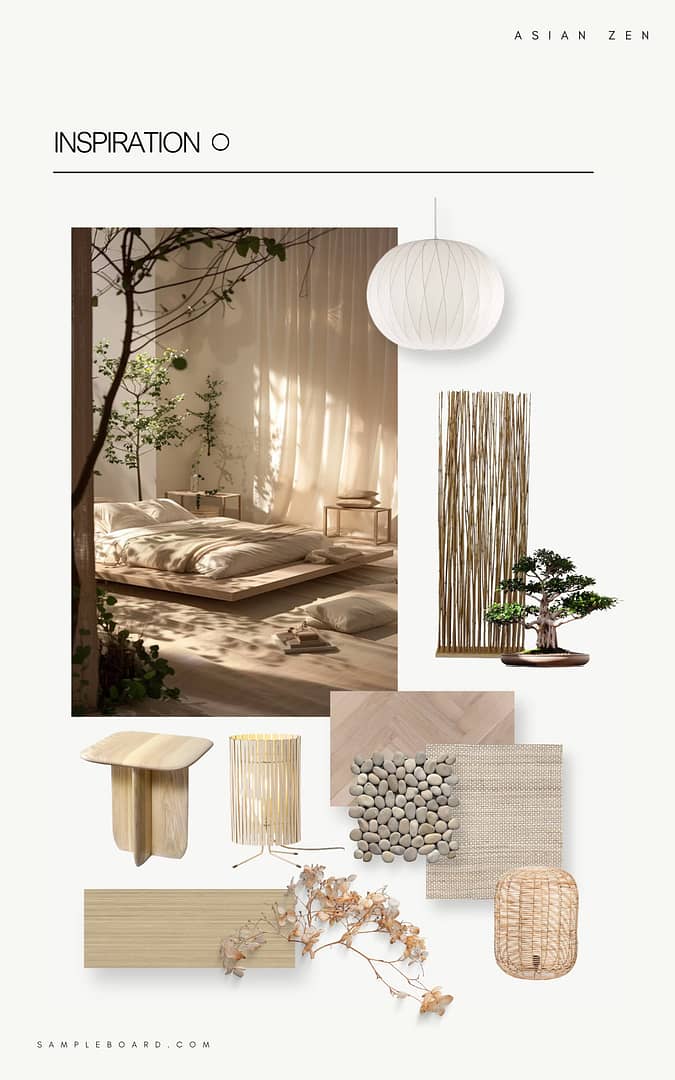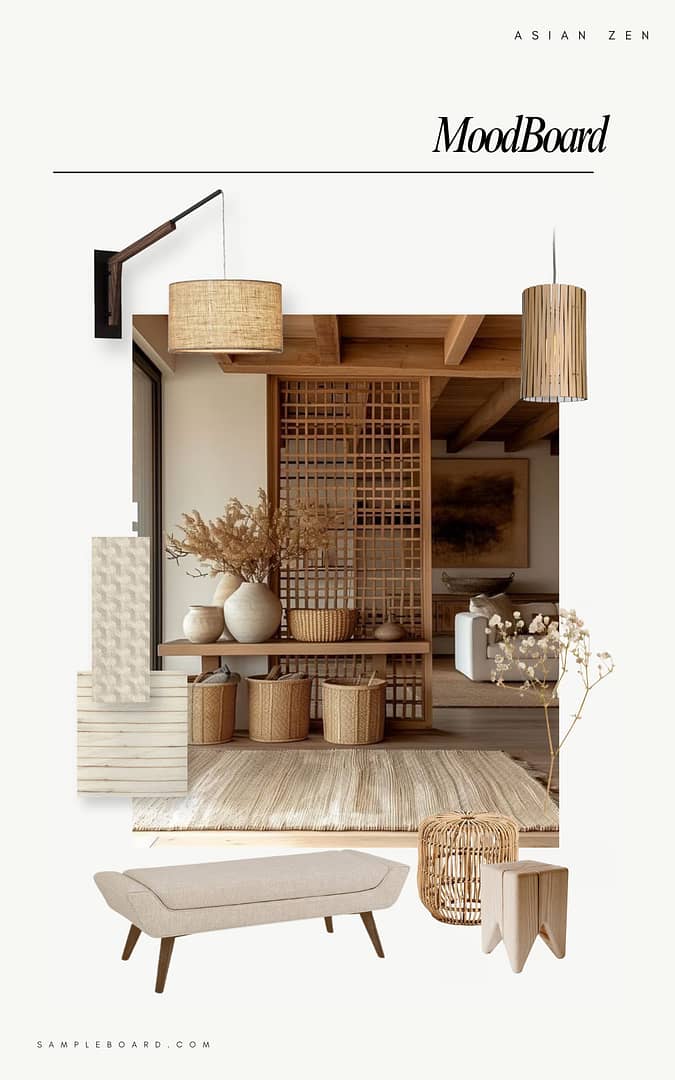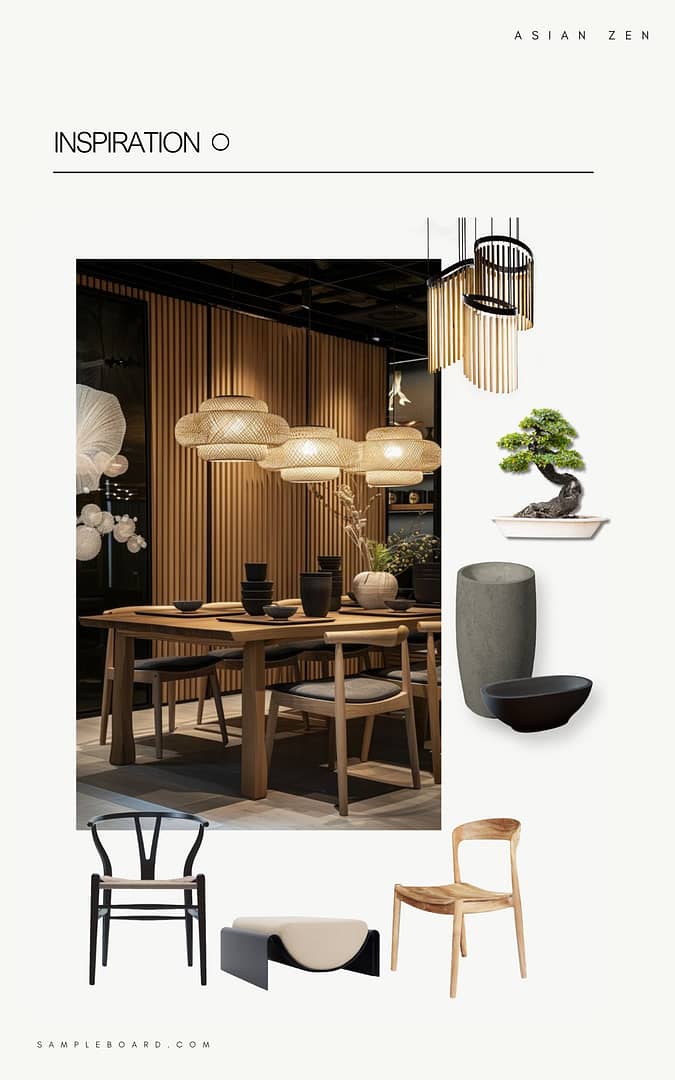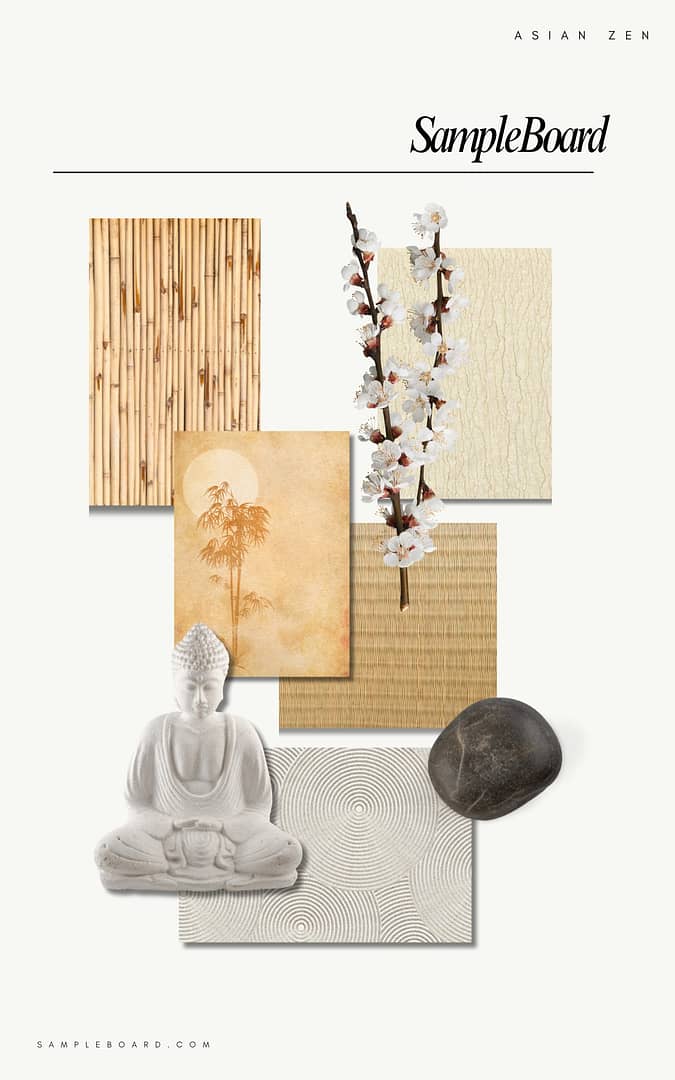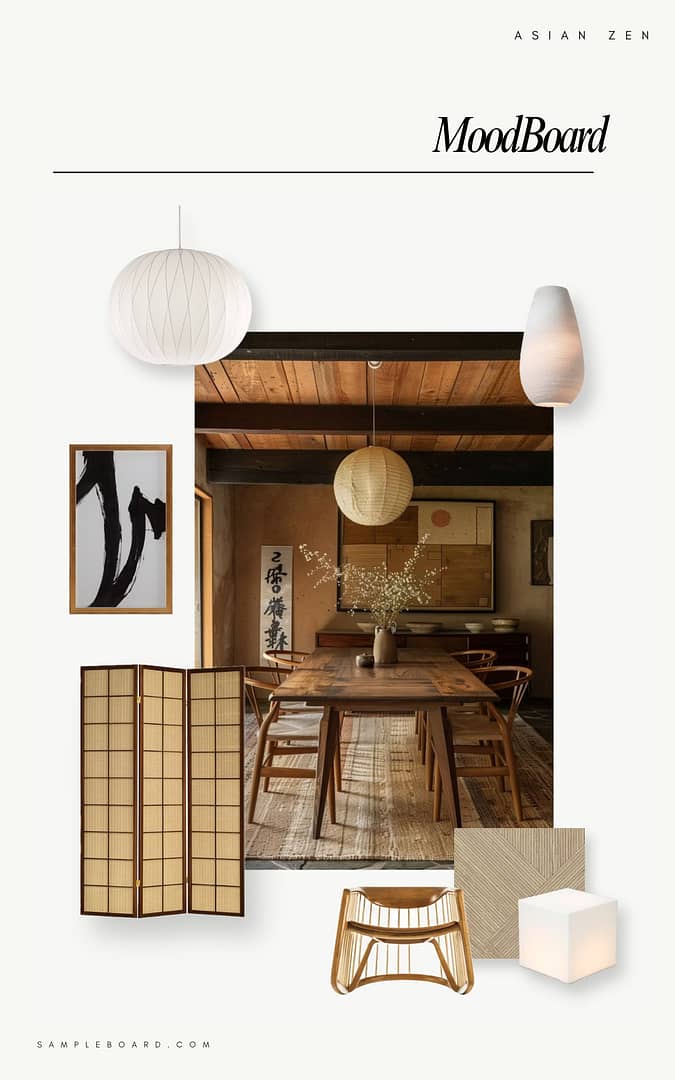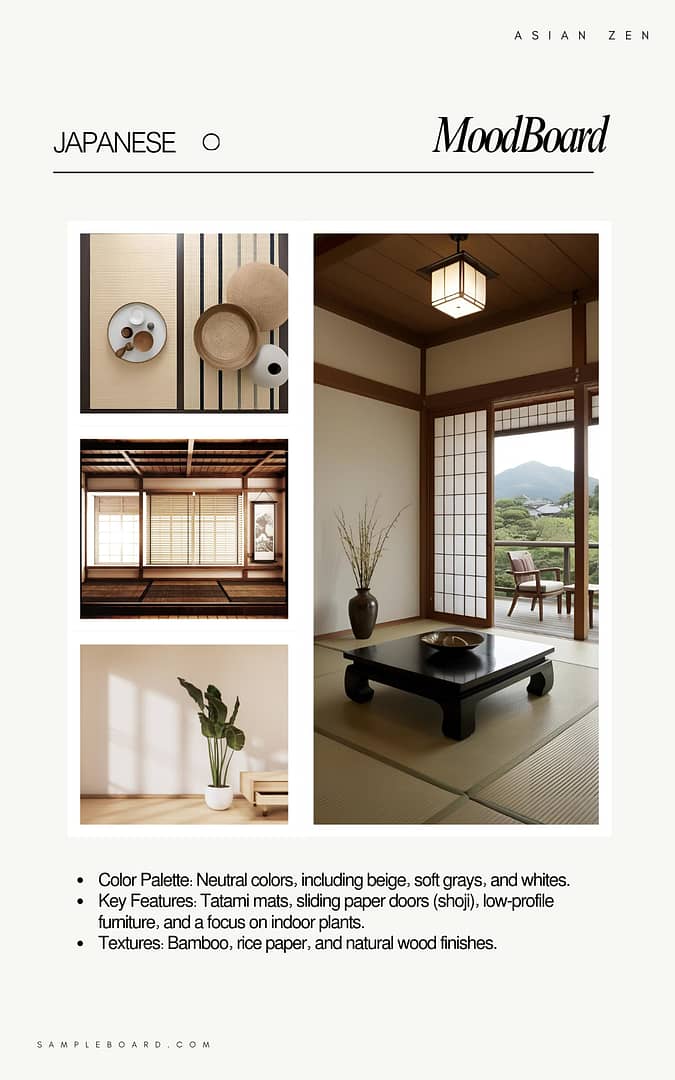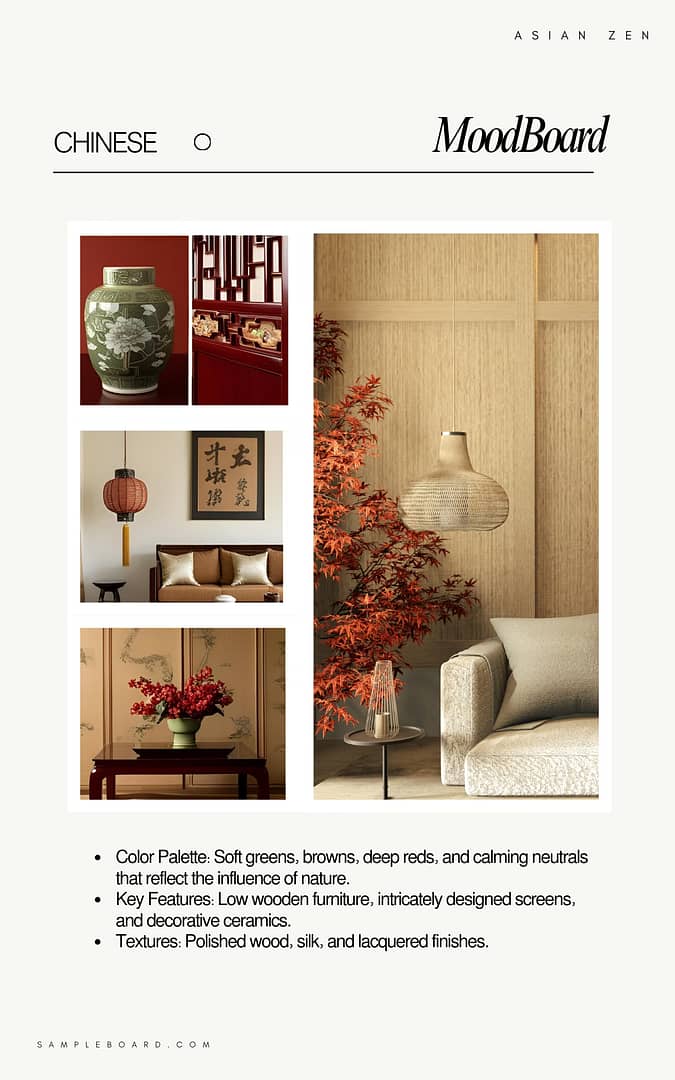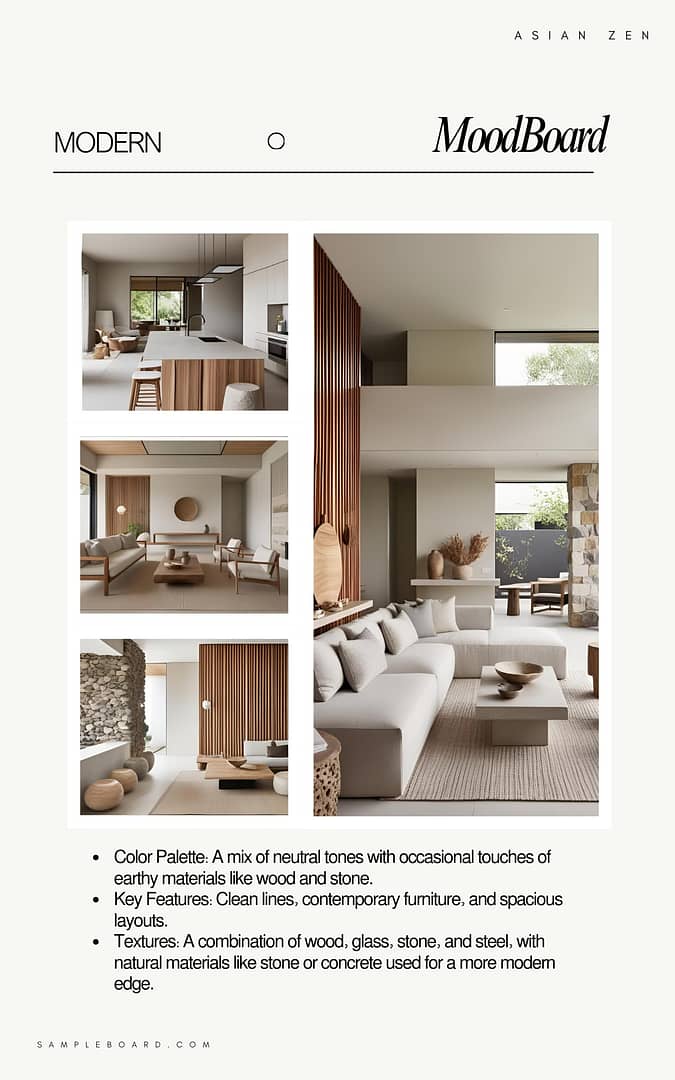Last Updated on May 28, 2025 by Tanya Janse van Rensburg
Asian Zen Interior design style is all about cultivating a tranquil environment that promotes relaxation, mindfulness, and balance.
Inspired by Zen Buddhism and traditional Asian design principles, this style emphasizes simplicity, natural materials, and a harmonious flow between indoor and outdoor spaces.
Whether you’re redesigning an entire room or just incorporating Zen-inspired touches, this guide will show you how to achieve the perfect Asian Zen look for your home.
Core Principles of Asian Zen Interior Design
The essence of Asian Zen interior design lies in its focus on balance, simplicity, and nature.
Understanding these key principles will help you create a calming, harmonious environment that encourages peace and tranquility.
1. Simplicity and Minimalism
Zen interiors are minimalist, emphasizing clean lines, functional furniture, and a clutter-free environment.
The idea is to create a serene space with only the essentials, allowing for a sense of calm and order. Every element should serve a purpose, avoiding excess decor.
2. Natural Materials and Earthy Tones
Zen design celebrates the beauty of natural materials such as wood, bamboo, stone, and paper.
A neutral, earthy color palette with shades of beige, gray, white, and soft browns fosters a peaceful atmosphere that connects the interior to nature.
3. Open, Flowing Spaces
The layout of a Zen-inspired home should be open and airy, with plenty of room for movement.
Creating a smooth flow between rooms and spaces is key to maintaining balance and harmony.
Open floor plans that encourage energy to circulate freely are ideal.
4. Tranquil and Balanced Ambiance
A Zen space should evoke feelings of peace and serenity. Lighting, furniture arrangement, and decor should all work together to maintain balance.
The space should feel effortless, calming, and in harmony with nature.
Asian Zen Interior Design Variations
While Asian Zen interior design maintains a core set of principles, some variations incorporate specific cultural influences or personal preferences.
Here are a few popular styles of Zen:
Japanese Zen
- Color Palette: Neutral colors, including beige, soft grays and whites.
- Key Features: Tatami mats, sliding paper doors (shoji), low-profile furniture, and a focus on indoor plants.
- Textures: Bamboo, rice paper, and natural wood finishes.
Japandi and Japanese Zen interiors draw inspiration from Japanese aesthetics but differ in style and focus.
- Japandi blends minimalist with cozy Scandinavian influences, emphasizing warmth.
- Japanese Zen centers on spiritual calmness, simplicity, and natural harmony.
Chinese Zen
- Color Palette: Soft greens, browns, deep reds, and calming neutrals that reflect the influence of nature.
- Key Features: Low wooden furniture, intricately designed screens, and decorative ceramics.
- Textures: Polished wood, silk, and lacquered finishes.
Modern Zen
- Color Palette: A mix of neutral tones with occasional touches of earthy materials like wood and stone.
- Key Features: Clean lines, contemporary furniture, and spacious layouts.
- Textures: A combination of wood, glass, stone, and steel, with natural materials like stone or concrete used for a more modern edge.
Room-by-Room Asian Zen Styling Guide
- Seating: Choose low, comfortable seating, such as floor cushions, simple wooden sofas, or futons. Maintain an uncluttered seating area for a more serene environment.
- Accent Furniture: Opt for minimalist, functional furniture with clean lines, like low wooden coffee tables or shelves. Keep furniture choices simple to avoid overcrowding the space.
- Lighting: Maximize natural light through large windows or sliding doors. Supplement with paper lanterns or minimalist floor lamps that provide soft, diffused lighting.
- Decor: Incorporate meaningful decor pieces, such as bonsai trees, stone sculptures, or small water features. Avoid clutter and keep only a few select decor items.
- Cabinetry: Simple, clean-lined cabinets made from wood or bamboo are ideal. Choose natural finishes to promote a calm, uncluttered look.
- Countertops: Stone, bamboo, or concrete countertops balance the rustic and modern elements of Zen design.
- Backsplash: Subway tiles or smooth stone tiles in neutral colors fit perfectly in a Zen-inspired kitchen.
- Fixtures: Sleek, minimalist fixtures in brushed metal or wood finishes will enhance the tranquil atmosphere.
- Lighting: Soft, ambient lighting from pendant lights or lanterns creates a calm mood.
- Table and Chairs: Opt for a low wooden dining table. Minimalist chairs or cushions on the floor will create a calm and welcoming atmosphere.
- Lighting: Use natural light as much as possible, supplemented by paper lanterns or simple pendant lights for a serene dining experience.
- Decor: A Zen-inspired centerpiece, such as a small vase of flowers, bonsai tree, or candles, will keep the focus on simplicity and tranquility.
- Bed Frame: Choose a low-profile bed frame made of wood or bamboo. Keep the bedding neutral in calming tones such as soft whites, grays, or blues. Linen or cotton fabrics are ideal for creating a comfortable retreat.
- Bedding: Use soft, breathable fabrics in neutral shades to create a serene sleeping environment.
- Nightstands: Opt for simple, wooden nightstands with minimal clutter. Use natural materials like bamboo or reclaimed wood.
- Lighting: Soft, diffused lighting from paper lanterns or low bedside lamps will enhance the peaceful atmosphere of the bedroom.
- Vanity: A wooden or stone vanity with clean lines and minimal hardware is perfect for a Zen-inspired bathroom.
- Tiles: Natural stone, bamboo, or ceramic tiles create a connection to nature, maintaining the tranquility of the space.
- Bathtub: A freestanding tub made from stone or wood is ideal for a Zen bathroom. It should feel like a serene, peaceful oasis.
- Fixtures: Simple, functional fixtures in matte black or brushed metal will maintain the minimalist aesthetic.
Styling Small Spaces in Zen Design
- Light Colors: Use light, neutral tones in small spaces to create the illusion of openness.
- Low Furniture: Choose low-profile furniture to make smaller rooms feel less cluttered and more spacious.
- Vertical Storage: Use wall-mounted shelves or storage units to keep the floor clear and maintain a sense of flow and balance.
Zen Lighting Guide
- Soft, Natural Light: Use large windows or sliding doors to allow natural light to flood the space. This connects the indoor environment with the outside world, fostering a calm atmosphere.
- Paper Lanterns: Incorporate soft, paper lanterns that diffuse light and create a warm, tranquil glow.
- Recessed Lighting: Soft, recessed lighting can enhance the simplicity of the space and create a warm ambiance.
- Candles: Simple candles in natural holders add warmth and a soothing atmosphere to a Zen room.
Sustainability in Asian Zen Interior Design
- Natural Materials: Incorporate sustainable materials like bamboo, stone, and reclaimed wood to enhance the Zen experience while being eco-friendly.
- Energy Efficiency: Use energy-efficient lighting like LED bulbs and invest in appliances that promote energy conservation.
- Indoor Plants: Add greenery, such as bonsai trees, succulents, or bamboo, to your space. Plants contribute to both the aesthetic and the overall calming effect of the environment.
DIY and Budget-Friendly Zen Decor Ideas
- Zen Garden: Create a simple Zen garden on a tray or tabletop using sand, stones, and small plants for a tranquil focal point.
- Paper Lanterns: Make your own paper lanterns using affordable materials to create soft, diffused lighting.
- Reclaimed Wood Shelving: Install simple shelves made from reclaimed wood to display plants or minimal decor.
- Stone Accents: Use smooth stones or pebbles for decor or a small water feature that fosters tranquility.
Zen Dos and Don’ts
Dos
✔ Keep the space clutter-free and minimalist.
✔ Use natural materials such as bamboo, wood, and stone.
✔ Incorporate plants to create a connection to nature.
✔ Emphasize soft, diffused lighting for a calming atmosphere.
✔ Keep furniture simple, functional, and low-profile.
Don’ts
✖ Overcrowd your space with excessive furniture or decor.
✖ Use overly bright or bold colors that disrupt the calming ambiance.
✖ Include too many decorative items—less is more in Zen design.
✖ Forget the importance of balance and harmony in the layout.
✖ Use harsh, artificial lighting that creates a stark, cold atmosphere.
Conclusion
Asian Zen style offers a serene and harmonious approach to interior design, focusing on simplicity, balance, and natural materials.
By embracing these principles, you can transform any space into a calming retreat that promotes peace and mindfulness.
Whether you’re incorporating Japanese, Chinese, or modern Zen elements, this guide will help you create an environment that is both functional and deeply tranquil.
Looking for more interior design inspiration? Stay tuned for more style guides and home decor tips!
